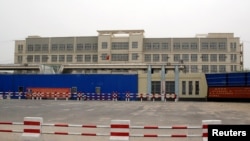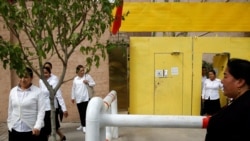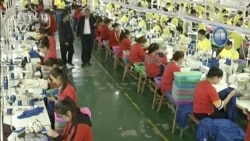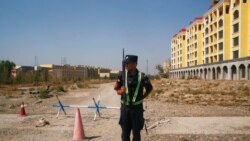On Sept. 23, the Australian Strategic Policy Institute (ASPI) published its “Xinjiang Data Project,” analyzing China’s years-long efforts targeting Uighurs in the autonomous region of Xinjiang in a campaign of forced political and cultural assimilation.
The report details the construction of mass detention centers under China’s so-called “re-education” strategy and the deliberate cultural destruction of mosques and shrines. It is the latest of a series of reports shedding light on the persecution of Uighurs, Kazahks and other mostly Muslim minorities by the Chinese government.
In response to the new report, the spokesman for China’s Ministry of Foreign Affairs, Wang Wenbin, dismissed the findings, denying that the country had destroyed thousands of mosques in west Xinjiang or that detention centers existed – and claiming some of the facilities found by ASPI’s research were an industrial park or a “five star residential area.” Wang called the report “fake news” and said it was “full of disinformation.”
The statements are false or misleading.
Over the past several years, reports, leaked government documents and a variety of investigations by rights groups and news organizations have produced abundant evidence of China’s extensive assimilation effort, which has been widely estimated to involve a million detainees.
Polygraph.info examined four of Wang's assertions on Sept. 25, 2020, after the ASPI report came out.
“The religious freedom, and other rights of people of all ethnic groups in Xinjiang, including the Uighurs, are fully protected.”
The “Karakax List,” a leaked internal government document with personal details of more than 3,000 people in the Xinjiang region, outlined the reasoning behind putting more than 310 people in detention centers and the decision-making processes for releasing or keeping them confined.
The Associated Press reported that of 484 people detained in these centers in the Karakax county of Xinjiang, 149 were detained for exceeding official birth quotas, “the most common reason for holding them.” Earlier this month, Polygraph.info wrote about the sterilization campaign targeting Uighurs.
Several news organizations interviewed Uighur women who’d been detained for re-education and said they were forced to have abortions or had contraceptive devices forcibly implanted. Some also said they received injections that either stopped menstruation or caused unusual bleeding, the BBC reported. Women beyond childbearing age were also targets.
In 2015, al Jazeera reported that China had banned civil servants, students and teachers in Xinjiang from fasting during the holy month of Ramadan. Dilxat Rexit, a spokesman for the exile group World Uyghur Congress, told the news agency that “China’s goal in prohibiting fasting is to forcibly move Uighurs away from their Muslim culture during Ramadan.”
Four years later, as groups were still decrying the ban, Lijian Zhao, then deputy chief of mission at China’s Embassy in Islamabad, told the Voice of America the restrictions were partial, focused on Ramadan activities, and not a blanket ban. “Restrictions are with the Communist Party members, who are atheists; government officials, who shall discharge their duties; and students who are with compulsory education and hard learning tasks,” Zhao said.
"Speaking of the number of mosques Xinjiang now has 24,000 mosques, one for every 530 Muslims, 10 times that of the U.S. and a higher ratio than in many Muslim countries.”
On Sept. 25, a New York Times interactive article detailed China’s efforts to erase mosques and shrines across Xinjiang:
“The Chinese authorities have in recent years closed and demolished many of the major shrines, mosques and other holy sites across Xinjiang that have long preserved the culture and Islamic beliefs of the region’s Muslims.”
The article was based on findings from ASPI’s report, which mapped and analyzed the conditions before and after 2017 of over 900 mosques and important Uighur religious-cultural sites across Xinjiang. The Times was able to verify much of the information in the report through satellite imagery and visits to sites across southern Xinjiang in 2019.
The government’s claim that the region “now has 24,000 mosques” is not supported by the ASPI findings. Instead, the researchers found that some 16,000 mosques had been destroyed or damaged “as a result of government policies since 2017.” Approximately 8,500 mosques were demolished in the past three years.
“We estimate the current number of mosques in Xinjiang is at its lowest level since the Cultural Revolution, when over 26,500 mosques were destroyed,” the report said. (China’s Cultural Revolution, from 1966 through 1976, was a period of political and cultural persecution and purges under the Communist Party that displaced millions and left hundreds of thousands dead.)
Other Uighur sacred sites, such as shrines, cemeteries and pilgrimage routes, were also analyzed, through a sample of 382 locations taken from online records and a state-sponsored survey, ASPI’s report shows. Thirty percent have been demolished (despite being protected under Chinese law) and nearly 28 percent have been damaged or altered.
“There has never been any so-called detention camps in Xinjiang.”
Numerous credible reports of the detention centers contradict this claim.
Authoritative reports suggest the Chinese government began detaining Uighurs in Xinjiang in 2014 – around the same time China blamed Uighur separatist groups for a series of terrorist attacks in the country. In response to the attacks, authorities began a "year-long campaign against terrorism," ramping up security and conducting military drills in Xinjiang, the BBC reported.
As Polygraph.info previously wrote, The New York Times’ “Xinjiang Papers” and the International Consortium of Investigative Journalists’ “China Cables” exposed government documents that revealed internal procedures for “dealing” with the Uighurs.
In late 2016, these efforts drastically expanded – and evidence of mass detention began to be reported internationally. At the time, buildings and old schools were repurposed to hold detainees. However, in 2018, the government began building facilities (fortified and with more security measures), an investigation by BuzzFeed News and the Pulitzer Center for Crisis Reporting found.
The same year, Shohrat Zakir, the chairman of Xinjiang province and a top Communist Party official, said in an interview with Xinhua News Agency that the region had launched “a vocational education and training program according to the law” – with a purpose to “get rid of the environment and soil that breeds terrorism and religious extremism and stop violent terrorist activities from happening.”
In January 2018, Radio Free Asia (RFA) reported that 120,000 Uighurs were being detained for showing signs of “extremism” and “politically incorrect views,” sourcing a security chief of Kashgar city. This was one of the first estimates of the number of detainees. (RFA and Voice of America are independent, taxpayer-funded news organizations under the U.S. Agency for Global Media.)
Since then, the estimate has risen sharply: a 2018 United Nations Human Rights panel said it had “many credible reports” that one million Uighurs were being held in what resembled a “massive internment camp that is shrouded in secrecy,” Reuters reported.
That estimate of one million detainees is most widely used, including by the Washington D.C.-based nonprofit Chinese Human Rights Defenders (CHRD) and German scholar Adrian Zenz, an expert on China’s detention of Muslims in Xinjiang.
In late 2019, Chinese authorities began claiming that those in so-called vocational centers had “graduated.” Yet Uighurs said their family members continued to be detained, according to The Associated Press. And the recent findings from the BuzzFeed/Pulitzer Center investigation and the ASPI report also dispute such claims, finding that new centers are going up even though some lower-security facilities have been mothballed.
The BuzzFeed/Pulitzer team cross-referenced satellite imagery to identify 268 detention compounds that had been built since 2017, with at least one in every county in the Xinjiang region. Reporters also interviewed 28 former detainees, “many of whom described being blindfolded and handcuffed.”
ASPI’s Xinjiang Data Project also used satellite imagery, examining night-time photos to find newly illuminated areas since 2017. The report identified 380 sites across the Xinjiang region, “counting only re-education camps, detention centres and prisons that were newly built or significantly expanded since 2017.”
These facilities were categorized in four security tiers based on features – such as watchtowers, high perimeter walls and fencing. About half of the newer sites are higher security, ASPI said.
“An address of those so-called detention camps, identified in this report, is the location of an electronic industrial park, and another one is even a five-star rating residence area.”
On Sept. 18, Nathan Ruser, a researcher at ASPI and lead author of the project, showed evidence to rebut the claim that one of the sites in the research was an apartment complex:
By comparing satellite images, Ruser showed how in April 2017, four apartments in a residential area were closed off to the rest of the community, with demountable warehouses and internal barbed wire fencing being built between them. In the months that followed, more construction was incorporated into the facility, similar to other lowest security detention facilities that were analyzed by ASPI.
Beyond the analysis of satellite imagery, ASPI had records of “official Chinese construction tenders that refer to the camp within Jinyuan Sunshine community,” Ruser wrote. Those records were originally found by activist Shawn Zhang.
Ruser noted that at the beginning of 2019, the internal fencing was mostly removed, “a pattern that you see across Xinjiang, where a number of the lowest security facilities have been desecuritised.” Recent reports suggest the center has been decomissioned and is no longer in use.
“I am confident in our data, and so far every concern that has been brought to me we have addressed and, in my opinion, allayed those concerns,” Ruser told Polygraph.info.
Ruser said he was unable to determine what industrial park Wang meant.
During the briefing, Wang criticized ASPI for “receiving funding from foreign forces to fabricate anti-China lies.”
ASPI is an independent, non-partisan think tank established by the Australian government in 2001, and partly funded by the country’s defense department.
The initial phase of the Xinjiang Data Project received a U.S. State Department research grant but was also supported by an independent advisory council, ASPI said on its web site.









